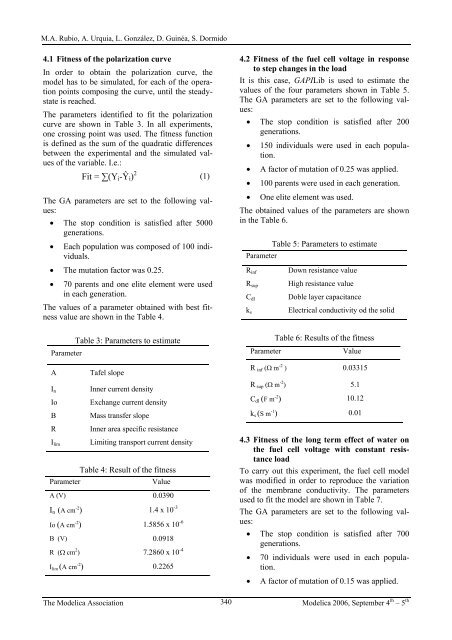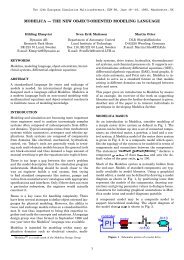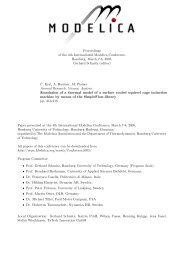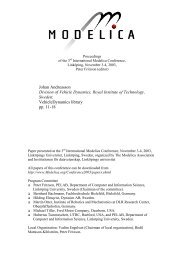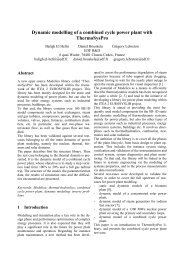- Page 1 and 2: 2006 Proceedings of the 5 th Intern
- Page 3 and 4: Preface Preface The first Internati
- Page 5 and 6: Table of Contents Volume 1 Table of
- Page 7 and 8: Table of Contents Using Modelica Mo
- Page 9 and 10: Table of Contents Vehicle Model for
- Page 11 and 12: Table of Contents Session 6b: Therm
- Page 13 and 14: Index of Authors Index of Authors A
- Page 15 and 16: Index of Authors Doppelhamer, J. On
- Page 17 and 18: Index of Authors Hirsch, T. Simulat
- Page 19 and 20: Index of Authors Matthes, P. Couple
- Page 21 and 22: Index of Authors Richter, C.C. Mode
- Page 23 and 24: Index of Authors Urquia, A. ARENALi
- Page 25 and 26: Session 4 Poster Session Session 4
- Page 27 and 28: GAPILib - A Modelica Library for Mo
- Page 29 and 30: GAPILib - A Modelica Library for Mo
- Page 31: GAPILib - A Modelica Library for Mo
- Page 35 and 36: Abstract Ascola: A Tool for Importi
- Page 37 and 38: 3.2 Mapping of Modelica Models to A
- Page 39 and 40: Figure 3: Graphical user interface
- Page 41 and 42: An Analyzer for Declarative Equatio
- Page 43 and 44: tential variable, and make these eq
- Page 45 and 46: connect(Sa.flange_b, Fa.flange_b);
- Page 47 and 48: e14: Emf.v = Emf.p.v-Emf.n.v e15: 0
- Page 49 and 50: Acknowledgement This work was suppo
- Page 51 and 52: Engineering Design Tool Standards a
- Page 53 and 54: symbols and their KKS designations
- Page 55 and 56: The code letter A3 provides a subcl
- Page 57 and 58: key, and display the tree in a navi
- Page 59 and 60: Engineering Design Tool Standards a
- Page 61 and 62: Abstract On the Noise Modelling and
- Page 63 and 64: 1..* Free_Noise_Model 1 Model Proce
- Page 65 and 66: The uniform random generator over t
- Page 67 and 68: References [1] Cellier, F.E., Conti
- Page 69 and 70: Abstract Acausal Modelling of Helic
- Page 71 and 72: ¨ b +Cf ˙ b + D f b = Hf The matr
- Page 73 and 74: unphysical algebraic loop by means
- Page 75 and 76: 4.2 Piloted flight Introducing a ve
- Page 77 and 78: Dynamicmodelingandcontrolofa6DOFpar
- Page 79 and 80: Xref Cartesian elasticity E { F�
- Page 81 and 82: Original system Feedforward control
- Page 83 and 84:
Modelling of Alternative Propulsion
- Page 85 and 86:
flange_a r FSlope = m Vehicle ⋅ g
- Page 87 and 88:
U SoE = U max 4 Control Strategies
- Page 89 and 90:
Figure 8: Comparison of the vehicle
- Page 91 and 92:
Abstract Modelling Automotive Hydra
- Page 93 and 94:
All components in the library exten
- Page 95 and 96:
accumulator needed to be sufficient
- Page 97 and 98:
Vehicle Model for Transient Simulat
- Page 99 and 100:
Vehicle Model for Transient Simulat
- Page 101 and 102:
Vehicle Model for Transient Simulat
- Page 103 and 104:
Abstract Modeling,CalibrationandCon
- Page 105 and 106:
tio,u[kgwater/kgdrysubstance],dryba
- Page 107 and 108:
Inparticular,thepapertemperatureisv
- Page 109 and 110:
acter. Thefinalproblemconsistsof953
- Page 111 and 112:
u[·] p sp [kPa] 0.04 0.035 0.03 50
- Page 113 and 114:
System and Component Design of Dire
- Page 115 and 116:
• specified cooling power for min
- Page 117 and 118:
tion). Thinking of the system as be
- Page 119 and 120:
nonlinear gas spring (section 2.2).
- Page 121 and 122:
3.3 Motor evaluation For comparison
- Page 123 and 124:
Abstract Multizone Airflow Model in
- Page 125 and 126:
K a [−] 1.04 1.03 1.02 1.01 1 0.9
- Page 127 and 128:
of the density at the two reference
- Page 129 and 130:
Table 1: Parameters of the flow ele
- Page 131 and 132:
References [1] ASHRAE. Fundamentals
- Page 133 and 134:
Modelling of a Solar Thermal Reacto
- Page 135 and 136:
Figure 3: Screenshot of the overall
- Page 137 and 138:
and the solar radiation are enterin
- Page 139 and 140:
input towards the rim and the radia
- Page 141 and 142:
Object Oriented Modelling of DISS S
- Page 143 and 144:
first one is a flooded evaporator a
- Page 145 and 146:
Tamb Rad InletTe... InletPre... mdo
- Page 147 and 148:
2 1 0 1000 500 600 400 mdot_in [Kg/
- Page 149 and 150:
Session 5a Language, Tools and Algo
- Page 151 and 152:
OpenModelica Development Environmen
- Page 153 and 154:
Figure 1. The architecture of Eclip
- Page 155 and 156:
OpenModelica Development Environmen
- Page 157 and 158:
ever, industry analysts suggested t
- Page 159 and 160:
A Modelica-based Format for Flexibl
- Page 161 and 162:
when {h b, c < a} which yields a p
- Page 163 and 164:
Jacobians Jacobians can be defined
- Page 165 and 166:
piler is able to create code for th
- Page 167 and 168:
A Modelica Based Format for Flexibl
- Page 169 and 170:
Dymola interface to Java - A Case S
- Page 171 and 172:
Record[] com.dynasim.record[] The r
- Page 173 and 174:
low background denotes ongoing simu
- Page 175 and 176:
4 Conclusions A new interface betwe
- Page 177 and 178:
Abstract Simulation of complex syst
- Page 179 and 180:
The following interfaces are curren
- Page 181 and 182:
Cond_mair duration... Cond_... k={i
- Page 183 and 184:
Session 5b Thermodynamic Systems fo
- Page 185 and 186:
Optimization of a Cooling Circuit w
- Page 187 and 188:
of the impeller wheel and the shove
- Page 189 and 190:
Figure 5: The measured and simulate
- Page 191 and 192:
8 Abbreviations ICE internal combus
- Page 193 and 194:
Abstract Using Modelica as a Design
- Page 195 and 196:
work with Modelica.Media and Modeli
- Page 197 and 198:
The above example is instantiated i
- Page 199 and 200:
The cooling power of the convention
- Page 201 and 202:
Abstract Modeling of Frost Growth o
- Page 203 and 204:
energy balance then reduces to the
- Page 205 and 206:
[5]. µ = 1 − ea + 10 F ea (1 −
- Page 207 and 208:
face temperature according to the u
- Page 209 and 210:
[4] Sanders, C. T., Frost Formation
- Page 211 and 212:
Multizone Building Model for Therma
- Page 213 and 214:
uncertainty in modeling assumption
- Page 215 and 216:
Table 1: Latent heat gains from occ
- Page 217 and 218:
is accurate enough for many room co
- Page 219 and 220:
Figure 2: View of room model in Dym
- Page 221 and 222:
Session 5c Free and Commercial Libr
- Page 223 and 224:
Abstract The LinearSystems library
- Page 225 and 226:
The data part of the record contain
- Page 227 and 228:
ing and Bessel filters, the step re
- Page 229 and 230:
the same discrete states (provided
- Page 231 and 232:
y� = x� x� =−b⋅ x+ u Ther
- Page 233 and 234:
ARENALib: A Modelica Library for Di
- Page 235 and 236:
a) b) c) d) e) f) Figure 1: ARENALi
- Page 237 and 238:
7 Data Modules Data modules represe
- Page 239 and 240:
a) b) Figure 2: Drilling center mod
- Page 241 and 242:
a) b) ARENALib: A Modelica Library
- Page 243 and 244:
Abstract Neural Network Library in
- Page 245 and 246:
Theorem 1 (Universal Approximator[4
- Page 247 and 248:
Figure 5: Library structure 3.1 Bas
- Page 249 and 250:
where x and y are the inputs of the
- Page 251 and 252:
previously identified through a spe
- Page 253 and 254:
Abstract The Modelica Multi-bond Gr
- Page 255 and 256:
solution for his or her task. Model
- Page 257 and 258:
The mass itself is represented by t
- Page 259 and 260:
where the variables of the rotation
- Page 261 and 262:
Table 3: Comparison of the two mech
- Page 263 and 264:
Session 5d Electric Systems and App
- Page 265 and 266:
The SmartElectricDrives Library - P
- Page 267 and 268:
cascaded structure deploying many e
- Page 269 and 270:
4.1 Simulations with ’ready-to-us
- Page 271 and 272:
The SmartElectricDrives Library - P
- Page 273 and 274:
Abstract Quasi-stationary AC Analys
- Page 275 and 276:
vt () = vˆ sin( ωt + ϕv) and rep
- Page 277 and 278:
containing real and imaginary part
- Page 279 and 280:
T n . (22) Slip s and torque T are
- Page 281 and 282:
changeover). Now, the phasor-domain
- Page 283 and 284:
Identi cation and Controls of Elect
- Page 285 and 286:
ules for setting the control parame
- Page 287 and 288:
warm excitation resistance = 2:5 W
- Page 289 and 290:
Figure 7: Observation of the interm
- Page 291 and 292:
Session 6a Language, Tools and Algo
- Page 293 and 294:
Dynamic Optimization of Energy Supp
- Page 295 and 296:
x = u x u u 0 1 I ( x) → min equa
- Page 297 and 298:
Fig. 9: Optimal loading courses 2.
- Page 299 and 300:
Fig. 16: Storage temperature course
- Page 301 and 302:
Abstract Robust Initialization of D
- Page 303 and 304:
situation is reached when all the c
- Page 305 and 306:
1. Use Pantelides algorithm to dete
- Page 307 and 308:
Figure 3. Voltage source. In order
- Page 309 and 310:
�������� ���
- Page 311 and 312:
� ����������
- Page 313 and 314:
�����������
- Page 315 and 316:
Abstract Automatic Fixed-point Code
- Page 317 and 318:
that sum up to the total word lengt
- Page 319 and 320:
In order to use fixed-point arithme
- Page 321 and 322:
Figure 5: Plot of reference speed a
- Page 323 and 324:
Session 6b Thermodynamic Systems an
- Page 325 and 326:
The Modelica Fluid and Media Librar
- Page 327 and 328:
The Modelica Fluid and Media Librar
- Page 329 and 330:
The Modelica Fluid and Media Librar
- Page 331 and 332:
The Modelica Fluid and Media Librar
- Page 333 and 334:
The Modelica Fluid and Media Librar
- Page 335 and 336:
Abstract Shock Wave Modeling for Mo
- Page 337 and 338:
limiter, simply a bounded function
- Page 339 and 340:
Using Roe’s averages and the diff
- Page 341 and 342:
Figure 9: Difference between single
- Page 343 and 344:
6 Conclusions and Future Work We ha
- Page 345 and 346:
Abstract Modeling of an Experimenta
- Page 347 and 348:
filled with a single or multiple-su
- Page 349 and 350:
A third solution variant would be t
- Page 351 and 352:
For the model of the batch plant th
- Page 353 and 354:
V1.open = controller.sensors.V1; an
- Page 355 and 356:
Integral Analysis for Thermo-Fluid
- Page 357 and 358:
where dU dt () t − q () t = q (5)
- Page 359 and 360:
3.2 Planar Wall with Convection Fig
- Page 361 and 362:
geometries. This approach allows th
- Page 363 and 364:
Session 6c Free and Commercial Libr
- Page 365 and 366:
Integration of CATIA with Modelica
- Page 367 and 368:
2. The CAD model of the components
- Page 369 and 370:
6 Conclusion We have presented an i
- Page 371 and 372:
A Modelica Library for Simulation o
- Page 373 and 374:
Saturation solubility m Ref / m Lub
- Page 375 and 376:
evaporator temperature sensor air v
- Page 377 and 378:
el. power consumption in [W] satura
- Page 379 and 380:
Abstract A New Energy Building Simu
- Page 381 and 382:
surroundings, such as outdoor air,
- Page 383 and 384:
tsol , tstd + L std L loc 15 =h w =
- Page 385 and 386:
Half exterior wall 1 West Half exte
- Page 387 and 388:
Incident Solar Radiation west, clou
- Page 389 and 390:
Abstract UnitTesting: A Library for
- Page 391 and 392:
unique name in the instance hierarc
- Page 393 and 394:
sion coverage, we simply divide the
- Page 395 and 396:
So far, we have only considered str
- Page 397 and 398:
from the report into the test case
- Page 399 and 400:
Session 6d Multidomain Systems Sess
- Page 401 and 402:
Abstract If we only had used XML...
- Page 403 and 404:
models, i.e. the Simple API for XML
- Page 405 and 406:
2.3.5 Retrieving data Figure 3: mat
- Page 407 and 408:
3.2 Dymola Following the object ori
- Page 409 and 410:
Figure 13: Motor speci cation Figur
- Page 411 and 412:
Coupled Simulation of Building Stru
- Page 413 and 414:
“match box” shaped room. In the
- Page 415 and 416:
Thermal effects can be described us
- Page 417 and 418:
The power control included in the h
- Page 419 and 420:
MWorks: a Modern IDE for Modeling a
- Page 421 and 422:
MWorks: a Modern IDE for Modeling a
- Page 423 and 424:
MWorks: a Modern IDE for Modeling a
- Page 425 and 426:
C.n.v = AC.n.v; G.p.v = AC.n.v; L.n
- Page 427 and 428:
Domain Library Preprocessing in MWo
- Page 429 and 430:
Domain Library Preprocessing in MWo
- Page 431 and 432:
Domain Library Preprocessing in MWo
- Page 433 and 434:
Domain Library Preprocessing in MWo


